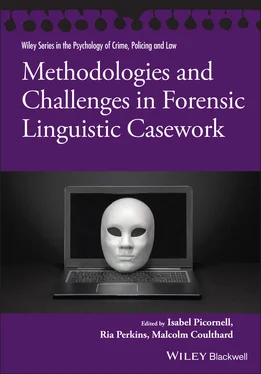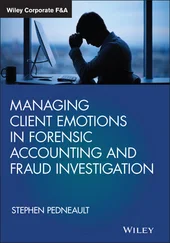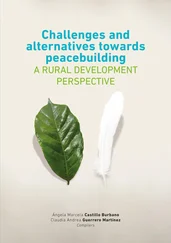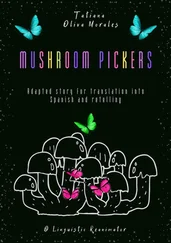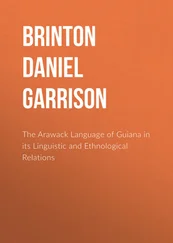Methodologies and Challenges in Forensic Linguistic Casework
Здесь есть возможность читать онлайн «Methodologies and Challenges in Forensic Linguistic Casework» — ознакомительный отрывок электронной книги совершенно бесплатно, а после прочтения отрывка купить полную версию. В некоторых случаях можно слушать аудио, скачать через торрент в формате fb2 и присутствует краткое содержание. Жанр: unrecognised, на английском языке. Описание произведения, (предисловие) а так же отзывы посетителей доступны на портале библиотеки ЛибКат.
- Название:Methodologies and Challenges in Forensic Linguistic Casework
- Автор:
- Жанр:
- Год:неизвестен
- ISBN:нет данных
- Рейтинг книги:3 / 5. Голосов: 1
-
Избранное:Добавить в избранное
- Отзывы:
-
Ваша оценка:
- 60
- 1
- 2
- 3
- 4
- 5
Methodologies and Challenges in Forensic Linguistic Casework: краткое содержание, описание и аннотация
Предлагаем к чтению аннотацию, описание, краткое содержание или предисловие (зависит от того, что написал сам автор книги «Methodologies and Challenges in Forensic Linguistic Casework»). Если вы не нашли необходимую информацию о книге — напишите в комментариях, мы постараемся отыскать её.
Discover more about Forensic Linguistics, a fascinating cross-disciplinary field from an international team of renowned contributors Methodologies and Challenges in Forensic Linguistic Casework
Methodologies and Challenges in Forensic Linguistic Casework — читать онлайн ознакомительный отрывок
Ниже представлен текст книги, разбитый по страницам. Система сохранения места последней прочитанной страницы, позволяет с удобством читать онлайн бесплатно книгу «Methodologies and Challenges in Forensic Linguistic Casework», без необходимости каждый раз заново искать на чём Вы остановились. Поставьте закладку, и сможете в любой момент перейти на страницу, на которой закончили чтение.
Интервал:
Закладка:
https://lccn.loc.gov/2021035760
Cover image: © Media Trading Ltd/Getty Images
Cover design by Wiley
Set in 10/12pt NewCenturySchlbk by Integra Software Services Pvt. Ltd, Pondicherry, India
We would like to dedicate this book to all our friends, colleagues, and family who have supported us, in particular Peter and Anita Perkins, and Carmen Rosa Caldas-Coulthard
Contents
1 Cover
2 Series page
3 Title page
4 Copyright
5 Dedication
6 Preface
7 Acknowledgement
8 About the Editors
9 1 Forensic Linguistic Casework
10 Section 1 2 The Starbuck Case: Methods for Addressing Confirmation Bias in Forensic Authorship Analysis 3 A Forensic Authorship Analysis of the Ayia Napa Rape Statement Lisa Donlan and Andrea Nini 4 Linguistic Profiling: A Spanish Case Study 5 Other Language Influence Detection: Profiling the Native Language of a Dark Web Pedophile 6 Forensic Plagiarism Detection and Analysis
11 Section 2 7 Mourning the Slow Death of Miranda: California v. Ceja 8 Detecting Faked Texts 9 Joining ISIS? A Pragmatic Discourse Analysis of Chat Messages in a Counterterrorism Case 10 “I Wanted to Leave A Long Time Ago”: Casework in Suicide Letter Analysis: Methods Used and Lessons Learned 11 Casework in Forensic Linguistics: Looking Outward
12 Index
13 End User License Agreement
List of Figures
1 Chapter 3 Table 2.1 Linguistic Feature ExamplesTable 3.1 List of Comparison Corpora UsedTable 3.2 Relative Frequency and Frequency...Table 3.3 Relative Frequency and Frequency...Table 3.4 Relative Frequency and Frequency...Table 3.5 Relative Frequency and Frequency...Table 3.6 Relative Frequency and Frequency...
2 Chapter 4Table 4.1 Timeline of Nogueira’s Victims andTable 4.2 Nogueira’s PsychologicalTable 4.3 Linguistic Samples Analyzed forTable 4.4 Instances of Masculine and FeminineTable 4.5 Examples of Excerpts Where the Author PortraysTable 4.6 Examples of the Use of EmoticonsTable 4.7 Some Expressions Typically UsedTable 4.8 Chatlog Excerpt Where the Author DescribesTable 4.9 Examples of Lexical ElementsTable 4.10 Checklist of Distinctive Linguistic FeaturesTable 4.11 Comparison Between the Linguistic
3 Chapter 5Table 5.1 Tongue Twister Literal TranslationsTable 5.2 Article Typologies
4 Chapter 6Table 6.1 Verbatim PlagiarismTable 6.2 Instance of plagiarism with alterations to the originalTable 6.3 Example of Reproduction of MistakesTable 6.4 Example of Translingual PlagiarismTable 6.5 Example of Translingual PlagiarismTable 6.6 Example of Translingual Plagiarism
5 Chapter 7Table 7.1 Questions and Responses in Spanish and
6 Chapter 8Table 8.1 Contextual Audience Analysis (CAA) Toolkit
7 Chapter 10Table 10.1 The SNAC Checklist of Linguistic Features
Guide
1 Cover
2 series page
3 Title page
4 Copyright
5 Dedication
6 Table of Contents
7 Series Preface
8 Acknowledgement
9 About the Editors
10 Begin Reading
11 Index
12 End User License Agreement
Pages
1 i
2 ii
3 iii
4 iv
5 v
6 vi
7 vii
8 viii
9 ix
10 x
11 xi
12 xii
13 xiii
14 xiv
15 1
16 2
17 3
18 4
19 5
20 6
21 7
22 8
23 9
24 10
25 11
26 12
27 13
28 14
29 15
30 16
31 17
32 18
33 19
34 20
35 21
36 22
37 23
38 24
39 25
40 26
41 27
42 28
43 29
44 30
45 31
46 32
47 33
48 34
49 35
50 36
51 37
52 38
53 39
54 40
55 41
56 42
57 43
58 44
59 45
60 46
61 47
62 48
63 49
64 50
65 51
66 52
67 53
68 54
69 55
70 56
71 57
72 58
73 59
74 60
75 61
76 62
77 63
78 64
79 65
80 66
81 67
82 68
83 69
84 70
85 71
86 72
87 73
88 74
89 75
90 76
91 77
92 78
93 79
94 80
95 81
96 82
97 83
98 84
99 85
100 86
101 87
102 88
103 89
104 90
105 91
106 92
107 93
108 94
109 95
110 96
111 97
112 98
113 99
114 100
115 101
116 102
117 103
118 104
119 105
120 106
121 107
122 108
123 109
124 110
125 111
126 112
127 113
128 114
129 115
130 116
131 117
132 118
133 119
134 120
135 121
136 122
137 123
138 124
139 125
140 126
141 127
142 128
143 129
144 130
145 131
146 132
147 133
148 134
149 135
150 136
151 137
152 138
153 139
154 140
155 141
156 142
157 143
158 144
159 145
160 146
161 147
162 148
163 149
164 150
165 151
166 152
167 153
168 154
169 155
170 156
171 157
172 158
173 159
174 160
175 161
176 162
177 163
178 164
179 165
180 166
181 167
182 168
183 169
184 170
185 171
186 172
187 173
188 174
189 175
190 176
Series Preface
The Wiley Series in the Psychology of Crime, Policing, and the Law publishes both single and multi-authored monographs and edited reviews of emerging areas of contemporary research. The purpose of this series is not merely to present research findings in a clear and readable form, but also to bring out their implications for both practice and policy. Books in this series are designed not only for psychologists, but also for all those involved in crime detection and prevention, child protection, policing, and judicial processes.
As the editors of Methodologies and Challenges in Forensic Linguistic Casework remind us, issues around the authorship and identity of written and spoken words reach back to Biblical times — the origins of the term ‘shibboleth’— through the true author(s) of Shakespeare’s plays and more recently, the musings of Sherlock Holmes and other fictional detectives. In our current century, these matters have assumed a new significance, where the validity and identity of electronic messaging and voice mail is, for many of us a daily challenge, while academics and students routinely employ the ‘ Turnitin ’ program to detect and prevent plagiarism.
An earlier volume in the Wiley Series had included some significant contributions on these themes (Oxburgh, Myklebust, Grant, & Milne, 2016), but this is the first book to be devoted entirely to forensic linguistics: an emerging science which combines the insights of psychology and linguistics in new and creative ways. Throughout its development, it has sought to combine theory with application and as the new book illustrates, its progenitors have found themselves caught up in major investigations both in the civil and criminal matters. One early high-profile case concerned the hunt for the serial killer known as the ‘Yorkshire Ripper’. In 1979, the police received a taped message, purportedly from the perpetrator, ridiculing their faltering investigations to date. The tape was passed to linguists at Leeds University who were asked to comment on the accent of the speaker. Their analysis of the cadences led them to conclude that he probably came from the village of Castletown, a suburb of Sunderland. This location fell well outside the suspect search area and was thoroughly investigated before being eventually discounted by the investigators. When the real murderer, Peter Sutcliff, was arrested, it was evident that the tape had been a hoax. The perpetrator, John Humble, who was subsequently arrested and convicted in 2006, had spent most of his life in and around Castletown, so the linguists had been correct in their judgement (Bilton, 2012).
Читать дальшеИнтервал:
Закладка:
Похожие книги на «Methodologies and Challenges in Forensic Linguistic Casework»
Представляем Вашему вниманию похожие книги на «Methodologies and Challenges in Forensic Linguistic Casework» списком для выбора. Мы отобрали схожую по названию и смыслу литературу в надежде предоставить читателям больше вариантов отыскать новые, интересные, ещё непрочитанные произведения.
Обсуждение, отзывы о книге «Methodologies and Challenges in Forensic Linguistic Casework» и просто собственные мнения читателей. Оставьте ваши комментарии, напишите, что Вы думаете о произведении, его смысле или главных героях. Укажите что конкретно понравилось, а что нет, и почему Вы так считаете.
